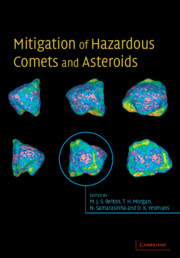Book contents
- Frontmatter
- Contents
- List of contributors
- Preface
- Acknowledgments
- Glossary
- 1 Recent progress in interpreting the nature of the near-Earth object population
- 2 Earth impactors: orbital characteristics and warning times
- 3 The role of radar in predicting and preventing asteroid and comet collisions with Earth
- 4 Interior structures for asteroids and cometary nuclei
- 5 What we know and don't know about surfaces of potentially hazardous small bodies
- 6 About deflecting asteroids and comets
- 7 Scientific requirements for understanding the near-Earth asteroid population
- 8 Physical properties of comets and asteroids inferred from fireball observations
- 9 Mitigation technologies and their requirements
- 10 Peering inside near-Earth objects with radio tomography
- 11 Seismological investigation of asteroid and comet interiors
- 12 Lander and penetrator science for near-Earth object mitigation studies
- 13 Optimal interception and deflection of Earth-approaching asteroids using low-thrust electric propulsion
- 14 Close proximity operations at small bodies: orbiting, hovering, and hopping
- 15 Mission operations in low-gravity regolith and dust
- 16 Impacts and the public: communicating the nature of the impact hazard
- 17 Towards a national program to remove the threat of hazardous NEOs
- Index
3 - The role of radar in predicting and preventing asteroid and comet collisions with Earth
Published online by Cambridge University Press: 12 October 2009
- Frontmatter
- Contents
- List of contributors
- Preface
- Acknowledgments
- Glossary
- 1 Recent progress in interpreting the nature of the near-Earth object population
- 2 Earth impactors: orbital characteristics and warning times
- 3 The role of radar in predicting and preventing asteroid and comet collisions with Earth
- 4 Interior structures for asteroids and cometary nuclei
- 5 What we know and don't know about surfaces of potentially hazardous small bodies
- 6 About deflecting asteroids and comets
- 7 Scientific requirements for understanding the near-Earth asteroid population
- 8 Physical properties of comets and asteroids inferred from fireball observations
- 9 Mitigation technologies and their requirements
- 10 Peering inside near-Earth objects with radio tomography
- 11 Seismological investigation of asteroid and comet interiors
- 12 Lander and penetrator science for near-Earth object mitigation studies
- 13 Optimal interception and deflection of Earth-approaching asteroids using low-thrust electric propulsion
- 14 Close proximity operations at small bodies: orbiting, hovering, and hopping
- 15 Mission operations in low-gravity regolith and dust
- 16 Impacts and the public: communicating the nature of the impact hazard
- 17 Towards a national program to remove the threat of hazardous NEOs
- Index
Summary
Introduction
The current Spaceguard Survey classifies each known near-Earth asteroid (NEA) as either non-threatening or deserving of additional astrometric attention. For any possibly threatening object, the dominant issues are the uncertainty in its trajectory and physical nature as well as what can be done to reduce that uncertainty. Morrison et al. (2002) note that
From the standpoint of an allocator of society's resources, an uncertain threat calls for adaptive policies, delaying potentially costly action but informing later decision by investing in uncertainty-reduction measures. In the context of the NEO impact hazard, this means avoiding the costs of standing organizational structures and capital expenditures until a threat materializes. …
Thus reduction in uncertainty is tantamount to ensuring that unnecessary costs are avoided and that necessary actions are undertaken with adequate warning.
Ground-based radar is a knowledge-gathering tool that is uniquely able to shrink uncertainty in NEO trajectories and physical properties. The power of radar stems largely from the precision of its measurements (Table 3.1). The resolution of echoes in time delay (range) and Doppler frequency (radial velocity) is often of order 1/100 the extent of a kilometer-sized target, so several thousand radar image pixels can be placed on the target. Delay-Doppler positional measurements often have a fractional precision finer than 1/10 000 000, comparable to sub-milliarcsecond optical astrometry.
The single-date signal-to-noise ratio (SNR) of echoes, a measure of the number of useful imaging pixels placed on a target by a given radar data set, depends primarily on the object's distance and size.
Information
- Type
- Chapter
- Information
- Mitigation of Hazardous Comets and Asteroids , pp. 38 - 65Publisher: Cambridge University PressPrint publication year: 2004
Accessibility standard: Unknown
Why this information is here
This section outlines the accessibility features of this content - including support for screen readers, full keyboard navigation and high-contrast display options. This may not be relevant for you.Accessibility Information
- 12
- Cited by
